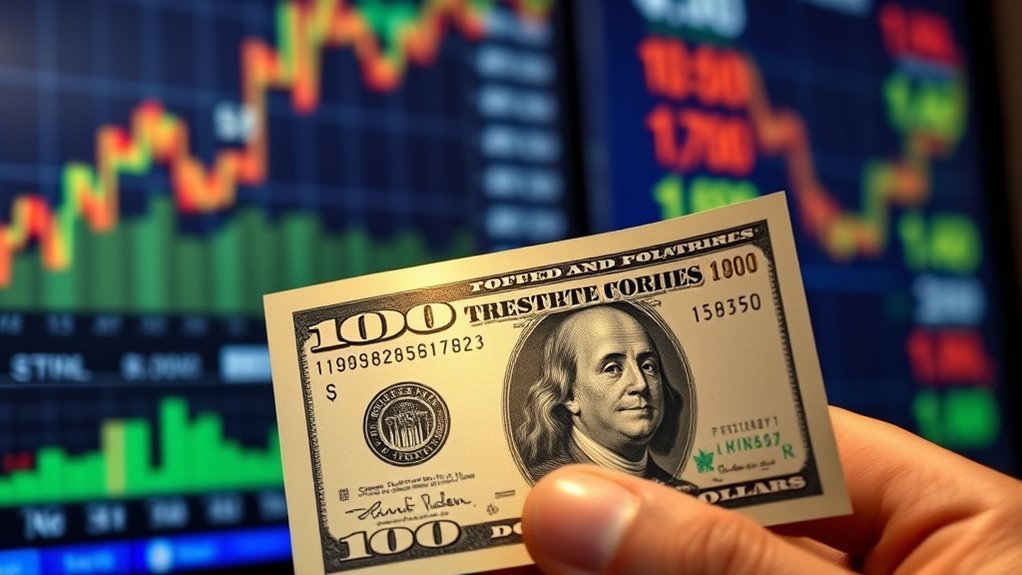The dollar gained ground after July’s producer price index data showed unexpected inflation increases, signaling persistent price pressures. You’ll see the dollar strengthen, with the Dollar Index surpassing 98, and commodity prices like silver falling. This data suggests the Fed may keep interest rates higher longer, impacting markets and investments. If you keep exploring, you’ll find out how these inflation signals could shape monetary policy and market trends moving forward.
Key Takeaways
- Strong July PPI data signals persistent inflation, boosting market expectations for sustained or higher interest rates.
- The dollar index surpasses 98.00, gaining approximately 0.25% amid inflation-driven optimism.
- Elevated producer prices, especially in energy and processed goods, reinforce inflation concerns supporting dollar strength.
- Increased inflation expectations lead traders to adjust positions, strengthening the dollar and affecting commodity prices.
- Market sentiment shifts as robust PPI data prompt the dollar to rally, reflecting confidence in ongoing inflation pressures.

Strong inflation data from July has propelled the U.S. dollar higher, with the Dollar Index (DXY) surpassing the 98.00 level and gaining approximately 0.25%. This surge reflects market expectations that inflation pressures remain persistent, prompting traders to adjust their positions accordingly. The latest Producer Price Index (PPI) figures reveal a robust increase in wholesale prices, signaling that inflation is not easing as quickly as some had anticipated. The final demand PPI rose 0.9% month-over-month, which is a notable jump, and the annual figure climbed 3.3%, exceeding the forecast of 2.5%. The core PPI, excluding food, energy, and trade services, increased 0.6% MoM, marking the largest rise since March 2022, and the annual core PPI advanced to 3.7%, up from June’s 2.6%. These numbers suggest that inflationary pressures are broad-based, affecting multiple sectors. Supply chain disruptions continue to drive energy prices higher, especially diesel fuel, which surged 11.8% MoM. This spike contributed over half of the increase in processed goods prices, highlighting how energy costs continue to pressure supply chains and production costs. Additionally, services such as trade and machinery experienced gains between 2.0% and 3.8%, accounting for roughly 75% of the overall PPI increase. Meanwhile, core goods showed mixed trends: meats rose sharply by 4.9%, while grains fell 5.8%, indicating that inflation is uneven across different commodities. Processed goods for intermediate demand also increased by 0.8%, the largest since January, with notable price pressures on industrial electric power, jet fuel, aluminum, and commercial electric power. The market responded swiftly to these inflation signals. The dollar strengthened, pushing the DXY above 98.00 and boosting it by about 0.25%. This rally erased recent declines and signaled traders’ expectations that the Federal Reserve might hold interest rates steady or even consider hikes if inflation remains stubborn. Elevated inflation figures increased speculation that the Fed won’t ease monetary policy soon, adding uncertainty to future rate moves. The stronger dollar also weighed on commodity prices, with silver dropping nearly 1.3%, approaching $38 per ounce. The inverse relationship between dollar strength and precious metals remains clear, and investors are closely monitoring the Gold/Silver ratio amid inflationary signals. Energy sector inflation pressures translate into higher input costs, impacting energy stocks and ETFs. Meanwhile, mixed trends in food commodities suggest investors might hedge their positions with futures or Treasury Inflation-Protected Securities (TIPS). Techniques for discovering intrinsic motivation can also help individuals maintain a positive outlook during uncertain economic times. The data complicates the Federal Reserve’s decision-making, as persistent inflation pressures combined with resilient labor market data—such as lower-than-expected jobless claims—support the case for maintaining or increasing interest rates. Overall, the July PPI figures reinforce the view that inflation remains a key concern, influencing both monetary policy outlook and market sentiment.
Frequently Asked Questions
How Does PPI Data Influence Consumer Inflation?
PPI data influences your perception of consumer inflation because rising producer prices often lead to higher retail prices over time. When PPI increases, producers face higher costs, which they may pass onto you eventually. This signals potential inflation down the line. Market watchers and policymakers pay close attention to PPI trends to anticipate future price hikes, guiding their decisions to manage inflation’s impact on your wallet.
What Are the Long-Term Effects of a Rising Dollar?
A rising dollar acts like a tide that lifts some boats and sinks others. In the long run, it can hurt U.S. exporters by making their goods more expensive abroad, while benefiting consumers with cheaper imports. It may also attract global investments, strengthening the economy but increasing risks for emerging markets. Over time, this shift could reshape trade dynamics and influence global financial stability, much like a tide changing the shoreline.
How Does PPI Compare to CPI in Market Analysis?
You compare PPI and CPI in market analysis by noting that PPI tracks prices from the producer’s perspective, serving as an early indicator of inflation, while CPI reflects consumer costs, influencing purchasing power. PPI can predict future CPI trends if producer costs pass through the supply chain. Both help you gauge inflationary pressures differently, with PPI focusing on upstream prices and CPI on actual consumer expenses.
What Sectors Benefit Most From a Stronger Dollar?
You’ll find that the technology, financial services, and industrial sectors benefit most from a stronger dollar. Tech companies gain from increased investment and stable supply chains, while financial firms see boosts from higher bond yields and currency trading. Industrials profit from lower input costs and domestic infrastructure projects, though export-heavy firms may face challenges. Overall, these sectors capitalize on the dollar’s strength to enhance earnings and investment opportunities.
How Might Future PPI Trends Affect Fed Policies?
Future PPI trends can influence your Federal Reserve’s policies substantially. If producer prices keep rising, the Fed might tighten monetary policy to curb inflation, possibly leading to higher interest rates. Conversely, if PPI stabilizes or declines, they may ease policies to support growth. Your Fed closely monitors PPI data as it signals upstream inflation pressures, guiding their decisions to balance inflation control and maximum employment.
Conclusion
So, after all that, it’s funny how strong July PPI data gave the dollar a boost, proving sometimes good news for the economy isn’t so good for your wallet. You might’ve thought a healthy economy would mean cheaper prices, but instead, it’s just making your dollar stretch a little less. Ironically, what seems like progress might just be a reminder that in currency world, nothing’s ever quite what it seems.









